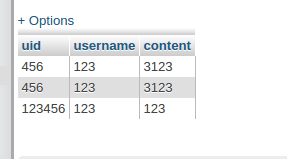本文实例讲述了php基于redis消息队列实现发布微博的方法。分享给大家供大家参考,具体如下:
phpredisadmin :github地址 图形化管理界面
|
1
2
3
|
git clone [url]https://github.com/erikdubbelboer/phpredisadmin.git[/url]cd phpredisadmingit clone [url]https://github.com/nrk/predis.git[/url] vendor |
首先安装上述的redis图形化管理界面,能够方便的管理redis数据

为了降低mysql的并发数,先把用户的微博存在redis中
假设用户发布的时候需要三个字段,uid(用户id号),username(用户姓名),content('用户的评论')
比如用户传递以下信息
|
1
2
3
4
5
6
7
8
9
10
11
12
13
14
15
16
17
|
//此处需要安装phpredis$redis = new redis();$redis->connect('127.0.0.1', 6379);// 连接redis$web_info= array('uid' => '123456','username' => '123','content' =>'123');//将数组转成json来存储$list = json_encode($web_info);//lpush向key对应的头部添加一个字符串元素$redis->lpush('weibo_lists',$list);$redis->close();///var_dump(json_encode($web_info));var_dump($list);?> |

此处可以看到我们的redis已经有数据了
|
1
2
3
4
5
6
7
8
9
10
11
12
13
14
|
//创建一个pdo数据库链接 data.phpclass qq{ public function post($uid='',$username='',$content=''){ try{ $dsn = "mysql:host;dbname=localhost;dbname=test"; $db = new pdo($dsn,'root','root'); $db->exec("set names utf8"); $sql ="insert into test(uid,username,content)values('$uid','$username','$content')"; $db->exec($sql); }catch(pdoexception $e){ $e->getmessage(); } }} |
|
1
2
3
4
5
6
7
8
9
10
11
12
13
14
15
|
//处理redis数据库的数据 并把数据放到mysql数据库中include "data.php";$qq = new qq();$redis = new redis();$redis->connect('127.0.0.1', 6379);//返回的列表的大小。如果列表不存在或为空,该命令返回0。如果该键不是列表,该命令返回falseif($redis -> lsize('weibo_lists')){ //从list头部删除并返回删除数据 $info = $redis->rpop('weibo_lists'); $info = json_decode($info); $qq->post($info->uid,$info->username,$info->content);}$redis->close();var_dump($info);?> |

我们能看到数据库已经有数据了
希望本文所述对大家php程序设计有所帮助。











